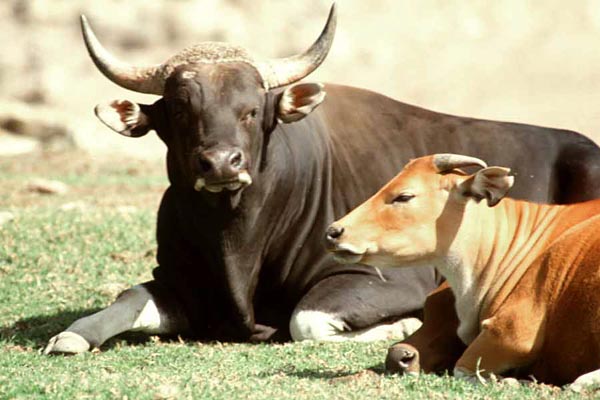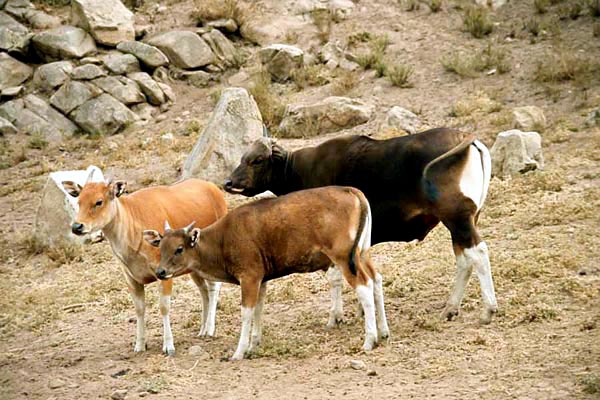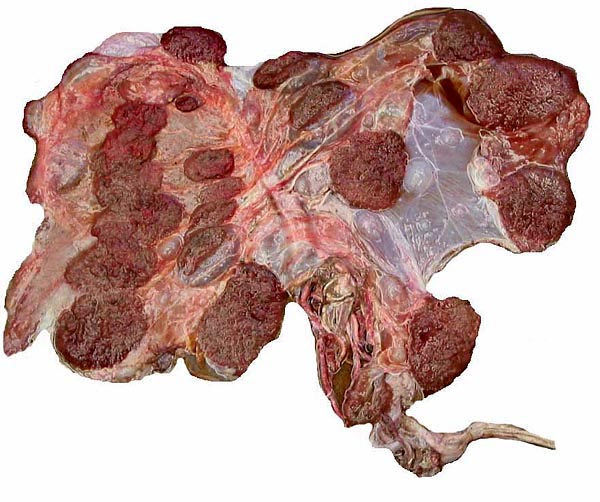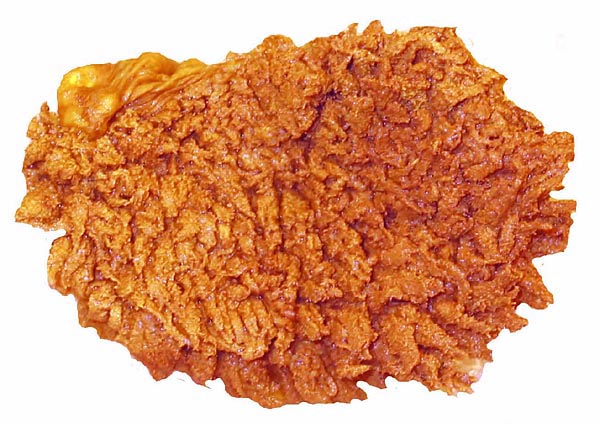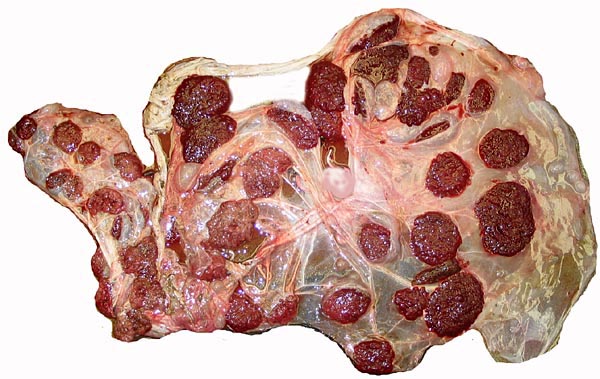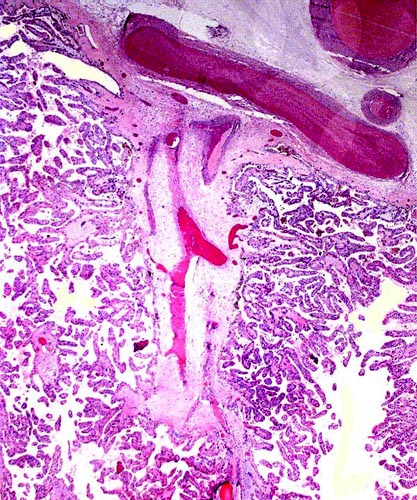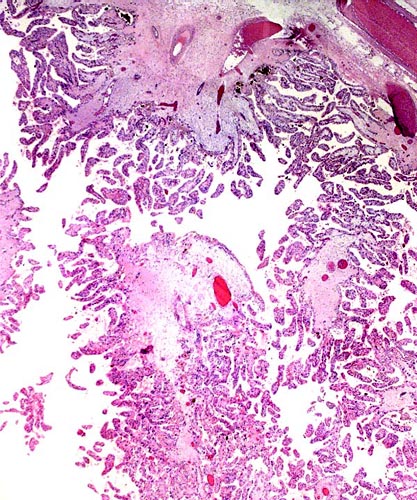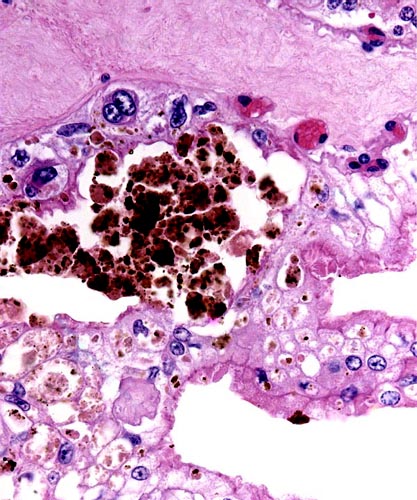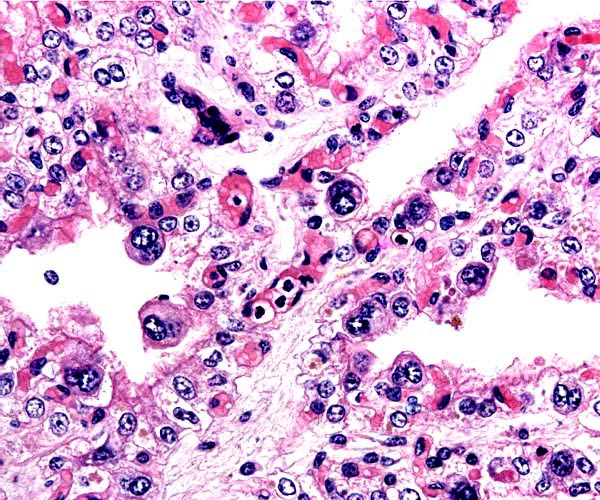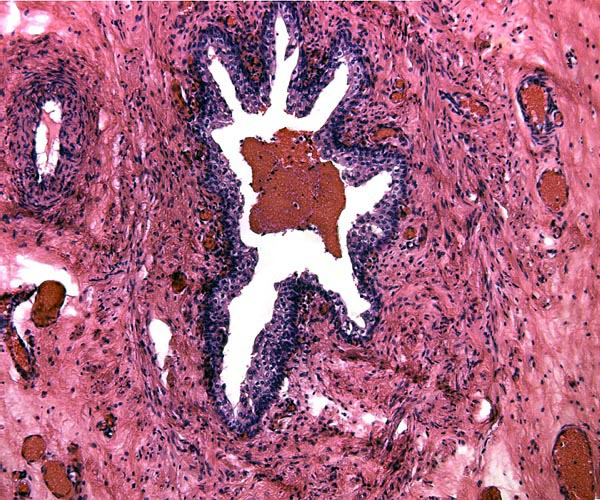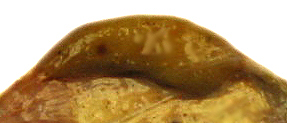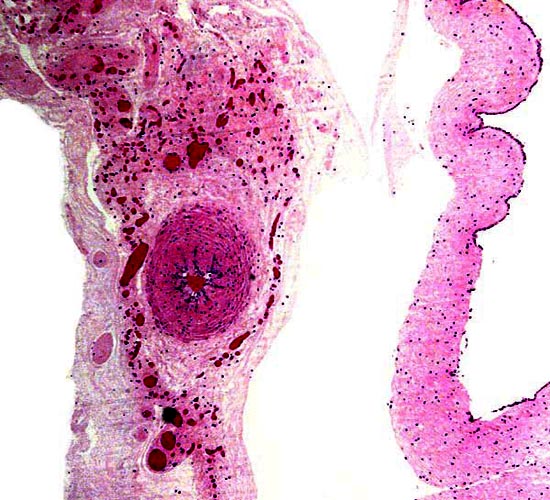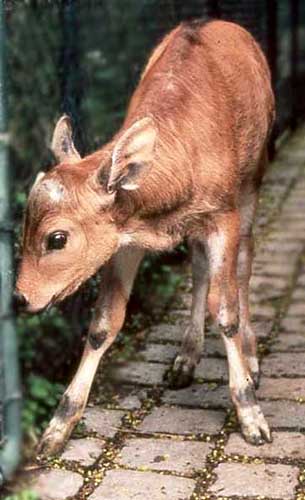The San Diego Zoo exhibits now the first successfully cloned male banteng. The source of cells was a male that died in a battle between bulls; it had been born in 1974 and the fibroblasts had been kept in the “Frozen Zoo” of the Society. With the help of a Biotech Company, an enucleated ovum from a Simmental cow was used to place the fibroblast nucleus and a normal offspring resulted that is shown next. Its undescended testes underwent orchiopexy at about one year of age and the young bull (now 2 years old in 2005) is placed with females. It is hoped that its rare genotype will be ‘reinjected’ into the banteng herd.
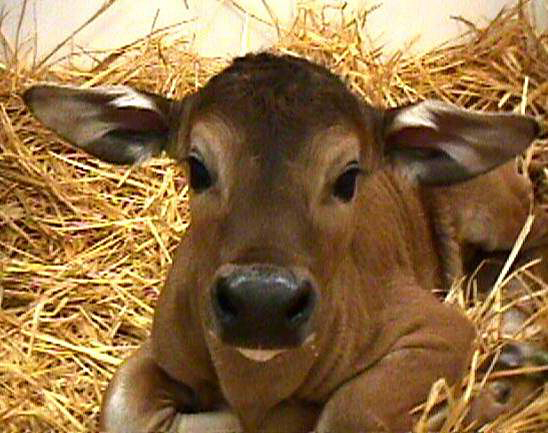 |
Neonatal cloned banteng bull. |
| |
|
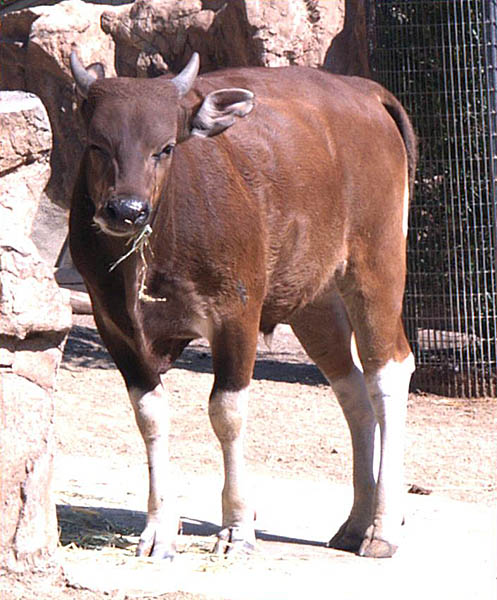 |
Cloned banteng bull at 2 years of age. |
| |
|
14) Immunology
I am not aware of any immunological studies.
15) Pathological features
Griner (1983) examined many banteng autopsies from the colony at the San Diego Zoo. He found omphalitis once in a newborn and many cases having died from malignant catarrhal fever (MCF) virus infection. Additional details on MCF may be found in the publication by Hatkin (1980). Similar outbreaks of MCF occurred at the Munich Zoo (Hanichen et al., 1998). Infection with Sarcocystis spp. was described by Odening et al. (1995).
Wild (1964) measured the surface of chorion and, separately, that of the cotyledons in domestic cow placentas in order to ascertain a possible relation to neonatal outcome. Whether this applies to banteng (whose cotyledonary surface is one fourth that of cattle) is unknown but will be of interest when banteng placentas from clones into cows become available.
16) Physiologic data
I know of no physiologic studies in this species, other than the protein electrophoretic reports mentioned at the beginning.
17) Other resources
Strains of fibroblast cultures from several banteng at the San Diego Zoo may be obtained by contacting Dr. Oliver Ryder at oryder@ucsd.edu.
18) Other remarks - What additional Information is needed?
Early implantational stages, and implanted placentas as well will be of interest in the future. The larger, flat cotyledons of this species differ much from the cotyledons of cattle with which they should be compared in better detail in the future also.
Acknowledgement
The animal photographs in this chapter come from the Zoological Society of San Diego. I appreciate also very much the help of the pathologists at the San Diego Zoo.
References
Bachmann, A.W., Campbell, R.S. and Yellowlees, D.: Haemoglobin in cattle and buffalo. Haemoglobin types of Bos taurus, Bos indicus, Bos banteng and Bubalis bubalis in northern Australia. Australian J. Exp. Biol. Med. Sci. 56:523-529, 1978.
Bell, K., Hopper, K.E. and McKenzie, H.A.: Bovine alpha-lactalbumin C and alpha S1-, beta- and kappa-caseins of Bali (Banteng) cattle Bos [Bibos] javanicus. Australian J. Biol. Sci. 34:149-159, 1981.
Bell, K., McKenzie, H.A. and Shaw, D.C.: Hemoglobin, serum albumin and transferring variants of Bali (Banteng) cattle, Bos [Bibos] javanicus. Comp. Biochem. Physiol. B 95:825-832, 1990.
Buntjer, J.B., Otsen, M., Nijman, I.J., Kuiper, M.T. and Lenstra, J.A.: Phylogeny of bovine species based on AFLP fingerprinting. Heredity 88:46-51, 2002.
Gallagher, D.S., Davis, S.K., DeDonato, M., Burzlaff, J.D., Womack, J.E., Taylor, J.F. and Kumamoto, A.T.: A molecular cytogenetic analysis of the tribe Bovini (Artiodactyla: Bovidae: Bovinae) with an emphasis on sex chromosome morphology and NOR distribution. Chromosome Res. 7:481-492, 1999.
Gotch, A.F.: Mammals - Their Latin Names Explained. Blandford Press, Poole, Dorset, 1979.
Gray, A.P.: Mammalian Hybrids. A Check-list with Bibliography. 2nd edition.
Commonwealth Agricultural Bureaux Farnham Royal, Slough, England, 1972.
Griner, L.A.: Pathology of Zoo Animals. Zoological Society of San Diego, San Diego, California, 1983.
Hanichen, T., Reid, H.W., Wiesner, H. and Hermanns, W.: Malignant catarrhal fever in zoo ruminants. Tieraerztl. Prax. Ausg. G. Grosstiere Nutztiere. 26:294-300, 1998 (in German).
Hatkin, J.: Endemic malignant catarrhal fever at the San Diego wild animal park. J. Wildl. Dis. 16:439-443, 1980.
Johnston, S.D., McGowan, M.R. and Blyde, D.: Birth of a Banteng (Bos javanicus) calf at Western Plains Zoo after fixed time artificial insemination. Australian Vet. J. 80:94-95, 2002.
Jones, M.L.: Longevity of ungulates in captivity. Intern. Zoo Yearbk. 32:159-169, 1993.
Mayr, B., Schweizer, D., Mendelak, M., Krutzler, J., Schleger, W., Kalat, M. and Auer, H.: Levels of conservation and variation of heterochromatin and nucleolus organizers in the Bovidae. Can. J. Genet. Cytol. 27:665-682, 1985.
Namikawa, T., Takenaka, O. and Takahashi, K.: Hemoglobin Bali (bovine): beta A 18(Bl)Lys leads to His: one of the "missing links" between beta A and beta B of domestic cattle exists in the Bali cattle (Bovinae, Bos banteng). Biochem. Genet. 21:787-796, 1983.
Nowak, R.M.: Walker's Mammals of the World. 6th ed. The Johns Hopkins Press, Baltimore, 1999.
Odening, K., Wesemeier, H.H., Walter, G. and Bockhardt, I.: On the morphological diagnostics and host specificity of the Sarcocystis species of some domesticated and wild bovini (cattle, Banteng and bison). Appl. Parasitol. 36:161-178, 1995.
Pathak, S. and Kieffer, N.M.: Sterility in hybrid cattle. I. Distribution of constitutive heterochromatin and nucleolus organizer regions in somatic and meiotic chromosomes. Cytogenet. Cell Genet. 24:42-52, 1979.
Potter, W.L. and Upton, P.C.: Y chromosome morphology of cattle. Australian Vet. J. 55:539-541, 1979.
Potter, W.L., Upton, P.C., Cooper, J. and Blackshaw, A.W.: C- and G-banding patterns and chromosomal morphology of some breeds of Australian cattle. Australian Vet. J. 55:560-567, 1979.
Puschmann, W.: Zootierhaltung. Vol. 2, Säugetiere. VEB Deutscher Landwirtschaftsverlag Berlin, 1989.
Steklenev, E.P. and Elistratova, T.M.: The characteristics of reproductive capacity of hybrids of banteng (Bos [Bibos] javanicus d'Alton) with the domestic cow (Bos[Bos] primigenius taurus). Tsitol. Genet. 26:45-57, 1992 (in Russian).
Wiesner, H., Lempeter, W.W. and Rietschel, W.: Erfahrungen beim unblutigen Embryotransfer vom Banteng auf Hausrinder. Verhandl. 26. Intern. Sympos. Erkrankungen der Zootiere. Brno, 1984. Akademie-Verlag, Berlin, pp.99-102, 1984.
Wild, A.: Untersuchungen über den Aufbau der Placenta fetalis des Rindes und ihre Auswirkungen auf die Gesundheit des Kalbes. Zbl. Veterinärmedizin "B". 11:60-89, 1964.
|
